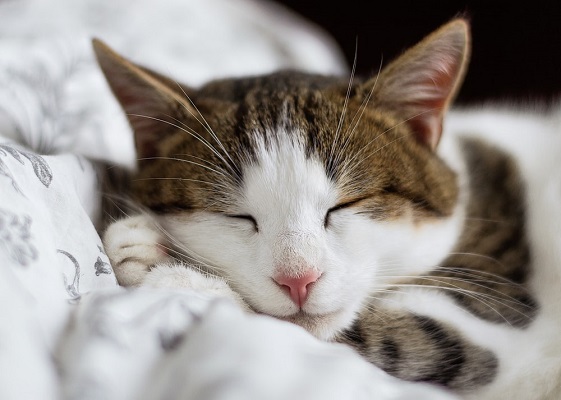A cat sleeps for about 14-16 hours per day, on average. Therefore, it is kind of difficult to imagine a scenario where your cat would need sedatives to make her sleep. Quite a few circumstances like traveling or Cat Grooming might require you to sedate her.
Moreover, sedating your cat for grooming is needed when your cat gets too agitated. In anxiety, she might injure herself with a comb or scissors. For this reason, we need to sedate some cats before we start to groom them.
Note: Make sure that you have the best cat grooming tools to reduce stress.
How to Sedate a Cat for Grooming?

If at any time you require to sedate your cat then it is best to take her to the vet. They will examine your cat thoroughly before prescribing any medications. It is important to understand your cat’s medical history in order to avoid any reactions to the sedatives.
Your veterinary doctor might anesthetize your cat before grooming her. They might also provide you with over the counter cat tranquilizer and the guidelines to follow at home.
Step 1: Check if the Sedative Works Best for Your Cat
Try giving the sedative to your cat once before you actually want to use it. Notice your cat’s behavior and see how long does she take to sleep or calm.
Never expect a medication to miraculously sedate your cat on the spot. Sedatives take time to calm the cat and every sedative has a different effect on each cat.
If the sedative doesn’t work as desired then talk to your veterinary doctor. If you notice any reaction from the drug, then consult the veterinarian doctor immediately.
Step 2: Wrap Your Cat in a Towel
If your vet has prescribed an oral sedative then begin by wrapping your cat with a towel. This will help you hold the cat still. Do not wrap her face. Open her mouth gently and put the pill or drops into her mouth.
Cats are not used to taking oral medications. Making your cat swallow the sedative pills will not be that easy for you. If your cat doesn’t swallow the pill then you can try to hide the pill into her food. Some drugs also come in powdered form. These can be sprinkled and mixed easily in the cat food.
You may ask your vet to provide you liquid drops rather than pills. You can easily put a few drops of the drug into your cat’s mouth. These drops can also be added to your cat water bowl as per the guidance of the veterinary doctor.
Never give a dose more than the prescribed amount. If accidentally you give an overdose then see your vet immediately.
Step 3: Start Grooming
Your cat might take 15-30 minutes to fall asleep or calm down. You may then start the grooming process. Grooming a cat mostly involves:
- Washing hairs with a shampoo (flea treatment shampoo to treat fleas)
- Removing fleas, mites, and maggots
- Drying and combing her hair
- Cutting or trimming her fur
- Applying the prescribed medications if any
- Detangling mats
If you are looking for some tips for cat grooming, you can refer to our guide.
Your cat will come out of the sedation in a few hours. The dosage is given according to the time required to groom the cat.
3 Way to Sedate a Cat while Grooming
Cat sedation can help you keep your cat safe, along with making the grooming sessions less troublesome. Methods of sedating a cat include relaxation techniques, injections, oral sedatives, and inhalers.
A sedative may help calm the central nervous system of a cat in a situation where she might get stressed out. A veterinarian would sedate your cat by any of the following sedating methods.
Injections: Drugs like Acepromazine, Ketamine, Hydromorphone or Diazepam are usually injected by a veterinary anesthetist. Cats are mostly quite sensitive to certain types of drugs. A vet can properly administer the amount of drug to be injected to sedate a cat.
Oral Sedative: Benadryl is considered a safe and effective oral liquid when anesthesia is not required. Take the veterinarian’s recommendation for the dosage amount.
Accurate dosage of drugs like Acepromazine is determined by the vet by looking at your cat’s size and age. Buspirone, Gabapentin, and Alprazolam are the most commonly prescribed pills to sedate cats.
Inhalers: Inhalable sedative medications used to sedate cats include Isoflurane, Sevoflurane, Halothane, and Acepromazine. Do not try giving inhalers without a vet’s help.
Usually, after covering the nose with the inhalers, cats do not sit still until the medication starts causing an effect. Hence the cat is placed in a box where gases of sedative inhalers, combined with oxygen, are pumped.
Cat Sedative Reaction
Acepromazine is usually used as a tranquilizer for many animals including cats. It is also used to manage motions sickness. The effect of this drug normally lasts for 6-8 hours though it may be increased in some cases.
Certainly, no medications are free from side effects. Sedatives may cause many reactions in cats just like in humans. Common reactions of sedating medicines in cats include:
- Hypertension
- Low blood pressure
- Increased heart rate
- Grown appetite
- Fear and anxiety
- Hallucinations
- Diarrhea and vomiting
- Aggression
- Uneasiness.
Sometimes sedation results in enhanced friendliness in cats. An overdose of a drug can lead to diarrhea, vomiting, high blood pressure, or even something more serious.
Acepromazine may react with many other drugs like antacids, pain relievers, and insecticides. Therefore it is best to talk to the vet about your cat’s medical history and other ongoing treatments.

Never Sedate a Cat Without Vet’s Advice
Some people avoid consulting a vet and try to sedate the cat by giving something that causes a reaction. Always take veterinarian advice before giving sedatives to your cat.
Diphenhydramine (Benadryl) is an antihistamine meant for humans. Do not use human drugs to treat or sedate your pets without a vet’s advice.
However, Why is Grooming so Essential?
Cats are well known for their excellent self-grooming habit. In spite of this fact, if your cat is infested by fleas or maggots you will have to help her groom. Cleaning your cat’s coat will make her feel quite comfortable in addition to preventing parasites and infections.
Whereas, few hairy cats may also develop mats and you will have to help detangle the mats for her. Also, grooming a cat is required when she is not able to groom herself in some situations. The need arises mostly in older cats or in those cats who are injured.
The necessity for you to groom a cat may vary on her breed, her grooming habits, her coat type, and the environment she lives in.
Final Note
Ideally, nothing is better than grooming your cat without any sedation. You may train your cat to stay calm while she is getting groomed. This takes time and needs patience. However, if a situation arises, when your cat is not trained and requires immediate grooming, then you can use sedatives.


My cat need some serious help with grooming. She is matted terribly and turns into a major B when I’ve tried. She been shaved twice within the past 6 years but it’s harder and harder now a days to find a vet that sedates and groom. Please any advice would be greatly appreciated. She is normally a sweet cat until you try to doing any kind of grooming
I am interested in getting my kitten groomed. Two professional groomers attempted to groom my kitten. But were unable to complete the procedure due to my kitten’s inability to relax. She quickly becomes anxious and very nervous. Snowflakes is 91/2 months old. She is a long haired Chinchilla. She still has mats in her fur which she wouldn’t allow the groomers to get to. Can you please help me?
I love the information that you gave about cats sedation I have an older cat that just get your nails clipped . And I was wondering if gabapentin could be given this is an older cat